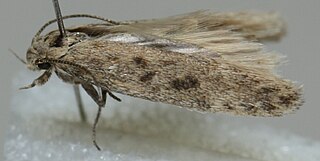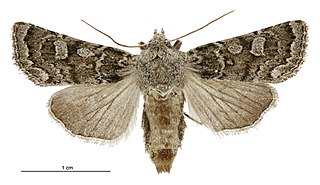
Monochroa is a genus of moths in the family Gelechiidae.

Monochroa lucidella is a moth of the family Gelechiidae. It is found in most of Europe, except Spain, Switzerland and most of the Balkan Peninsula. It is recorded from the Near East and Siberia (Transbaikalia).

Stigmella cypracma is a species of moth of the family Nepticulidae. It is endemic to New Zealand and has been observed in the North and South Islands. The larvae of this species are leaf miners and pupate within their mines. The larval host species is Brachyglottis repanda. Adult moths are on the wing in February and September to November. This species has two generations per year.

Scrobipalpa obsoletella, the summer groundling, is a moth of the family Gelechiidae. It is found in most of Europe, Turkey, the Caucasus, from Iran to Asian Russia (Transbaikal) and Mongolia. It has also been recorded from New Zealand, South Africa and North America, where it is probably an introduced species. The habitat consists of coastal salt marshes and sandy beaches.

Culladia strophaea is a species of moth in the family Crambidae. It is endemic to New Zealand. The taxonomy of this species is currently uncertain.
Monochroa absconditella is a moth of the family Gelechiidae. It was described by Francis Walker in 1864. It is found in North America, where it has been recorded from Florida, Illinois, Maine, Mississippi, New Hampshire and Ohio.
Monochroa cleodora is a moth of the family Gelechiidae. It was described by Edward Meyrick in 1935. It is found in Japan and Korea.
Monochroa discriminata is a moth of the family Gelechiidae. It was described by Edward Meyrick in 1923. It is found in North America, where it has been recorded from southern Ontario.
Monochroa monactis is a moth of the family Gelechiidae. It was described by Edward Meyrick in 1923. It is found in North America, where it has been recorded from southern Ontario and North Carolina.
Monochroa perterrita is a moth of the family Gelechiidae. It was described by Edward Meyrick in 1923. It is found in North America, where it has been recorded from southern Ontario.
Monochroa pallida is a moth of the family Gelechiidae. It was described by Sakamaki in 1996. It is found in Japan.
Monochroa pentameris is a moth of the family Gelechiidae. It was described by Edward Meyrick in 1931. It is found on Honshu in Japan and Guangxi in China.
Monochroa ingravata is a moth of the family Gelechiidae. It was described by Edward Meyrick in 1918. It is found in the Bengal region of what was then British India.
Monochroa repudiata is a moth of the family Gelechiidae. It was described by Edward Meyrick in 1923. It is found in Assam, India.
Monochroa pessocrossa is a moth of the family Gelechiidae. It was described by Edward Meyrick in 1926. It is found in the Russian Far East.
Monochroa drosocrypta is a moth of the family Gelechiidae. It was described by Edward Meyrick in 1926. It is found in the Russian Far East.
Monochroa ainella is a moth of the family Gelechiidae. It was described by Pierre Chrétien in 1908. It is found in Algeria.
Tinea dubiella is a species of moth belonging to the family Tineidae.

Ichneutica chlorodonta, also known as the Green-toothed Owlet, is a moth of the family Noctuidae. This species is endemic to New Zealand. It is found throughout the North, South and Stewart Islands and is associated with native forest and shrubland. It can be confused with similar looking species such as I. subcyprea however I. chlorodonta can be distinguished through differences in colouration of its fore and hind wings as well as the length of the male pectinations. The life history of this species is unknown as are the host species of its larvae but adults of I. chlorodonta are on the wing from September to April.

Ichneutica sistens is a moth of the family Noctuidae. This species is endemic to New Zealand. It can be found in the central North Island and throughout the South Island, although it is more common on the eastern side of that latter Island. It is very variable in both colour and size. I. sistens prefers open habitat such as tussock grasslands, dunes and braided rivers. Larval host species include grasses in the family Poaceae and include species in the genera Rytidosperma and Elymus, as well as Poa cita and Agrostis capillaris. Adults are on the wing from January to May and are attracted to light.





